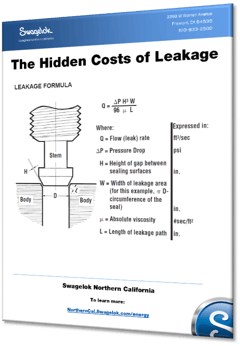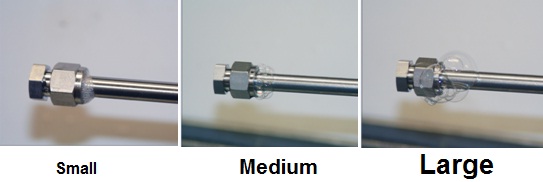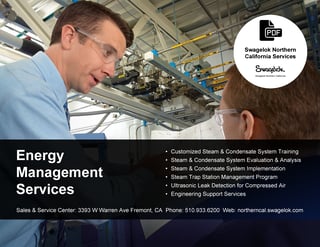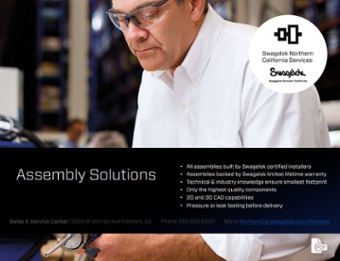Share this
Energy Management: Leak Detection + Leak Prevention = More Profit
by Jeff Hopkins on 8/31/17 8:45 AM
Whether it's an inboard, outboard, or virtual leak, no man-made system will always be leak-free, but that won't stop us from trying to make one
We believe that one leak is one too many. Learn how Swagelok Northern California can help your system become leak tight and save you energy and money through Energy Management Services »
Inboard, outboard, internal
Everyone knows what a leak is: unwanted flow out of (or into) a system. Finding, analyzing and fixing leaks can get a bit complex. It's worth learning about, though, because there is no man-made system in the world that will always be completely leak-free.
Let's fine-tune our definitions of leakage. It could be inboard leakage, where something is flowing into the system from outside. It could be outboard leakage, where something is flowing out of containment into the environment. Or it could be internal leakage, where something is flowing across internal seals within containment, such as a leaky valve seat. There can even be virtual leaks, where nothing is breaching the containment, but internally trapped fluid gets released into the system due to material out-gassing, absorbed or adsorbed fluids, entrapment in cracks or dead-legs, etc.
Leakage can take many forms: compressed air leaking out of a pneumatic system, steam escaping from a processing line, hydraulic fluid seeping out of machinery.
How leaks happen
Bad installation techniques are frequent causes of leaks. Common mistakes include failing to fully insert tubing into the tube fitting body, under-tightening, over-tightening, putting bends in the tubing too close to the end of the tube, and poorly preparing the tube. Surface defects such as dents and scratches can lead to leaks too. Another cause of leakage is using components outside their rated temperature and pressure ratings or with incompatible materials. Also, low quality fluid system components also contribute to leaks. Proper selection of high quality fluid system components are an integral part of creating leak tight fluid systems.
More common than you think
Leaks are more common than many people realize, and more costly. A group of 1,304 different process installations leak checked more than 600,000 fittings for a five-year period ending in September 2013, and reported the results to Swagelok Company. Almost 10% of the fittings that had been interchanged or intermixed with another manufacturer's components were found leaking, and pipe fittings had a leak rate of about 7 percent. In contrast, Swagelok tube fittings had a leak rate of about 1%. (This data is not offered as test results that are scientifically valid or statistically significant.)
While the 1% leak rate for Swagelok fittings is 7-10 times better than pipe fittings and intermixed/interchaged fittings, we believe that one leak is one too many. So, we strive to get to the root cause of every leak. We find that many Swagelok tube fittings are not installed according to our installation instructions. Poor installation practices, low quality tubing, improper tubing or fitting selection - all these contribute to leak rates. We have found that customer leak rates can approach zero when Swagelok tube fittings are used in concert with high quality tubing, a robust Swagelok safety and installation training program, and energy management services.
Leaks are more common than many people realize, and more costly.
The cost of leakage
The leak data noted above correlates well with a study performed by Dr. Arthur Sterling of the Chemical  Engineering Department at Louisiana State University in 1999. Dr. Sterling surveyed eleven industrial plants in the Louisiana area and determined that leaks were present in many areas of the plant. The average instrument air leak was 494 milliliters per minute. Using a cost of $0.40 per 1000 cubic feet of instrument air, the average fitting leak costs $0.31 per month.
Engineering Department at Louisiana State University in 1999. Dr. Sterling surveyed eleven industrial plants in the Louisiana area and determined that leaks were present in many areas of the plant. The average instrument air leak was 494 milliliters per minute. Using a cost of $0.40 per 1000 cubic feet of instrument air, the average fitting leak costs $0.31 per month.
Leaks can damage equipment, hurt production, cause product contamination, and create unsafe working conditions and other health hazards. All it takes is a small puddle of hydraulic fluid or a jet of steam to put someone in the hospital. If that is not motivation enough to engage in proactive leak detection and prevention programs, fluid loss is also expensive. According to a study conducted by the Energy Department's Office of Industrial Technologies, even something as simple as a ¼” diameter leak of compressed air can cost as much as $8,382 a year using a rate of five cents per kWh and assuming constant operation and an efficient compressor.
How to find leaks
We have a few ways to spot leaks. One is to put the suspect parts under water in a chamber made of transparent polycarbonate and look for bubbles. Another is to apply one of our Snoop® liquid leak detectors. When the parts are pressurized, the leak will produce bubbles. Leaks are usually expressed as a flow — a volume per unit of time. Anyone using Snoop will get the basic idea instantly: the bigger the bubbles, the worse the leak.

Leaks can also be detected by measuring losses in pressure, and of course by simply looking to see if any fluid is escaping. Technology has added to the arsenal of tools. The list now includes thermal imaging cameras and ultrasonic (acoustic) leak detectors.
How to deal with leaks
Any good energy management program should include efforts to prevent and repair leaks. If you don't have such a program, start one. If you already are making the effort, make sure you document any resulting energy savings. You may be surprised at how fast leak prevention and repair can pay for itself. You'll have lower maintenance costs, less downtime, higher production, and safer workers. Lower overall system costs add up to more profitability. And of course, we are here to help, you can learn about our Energy Management Services here »
additional resources
get in touch
In a hurry or have a question? Please click here to get in touch - we respond fast! Or call 510-933-6200.
Share this
- Archive (465)
- Assembly Services (207)
- About (100)
- Seal Support Systems (96)
- Best Practices (88)
- Training Services (74)
- Fittings (51)
- Semiconductor Applications (49)
- Hoses and Flexible Tubing (47)
- Regulators (44)
- Tubing (42)
- Grab Sampling Systems (32)
- Sampling Systems (32)
- Gas Systems (30)
- Services (30)
- Downloads (29)
- Valves (24)
- Application Support (18)
- Orbital Welding (17)
- Case Studies (13)
- Steam Systems (13)
- Frequently Asked Questions (12)
- Tools (12)
- Measurement Devices (7)
- Subsystems (6)
- Thermal Management (6)
- September 2023 (1)
- August 2023 (2)
- June 2023 (1)
- March 2023 (3)
- February 2023 (3)
- January 2023 (4)
- December 2022 (4)
- November 2022 (4)
- October 2022 (4)
- September 2022 (1)
- August 2022 (3)
- July 2022 (2)
- June 2022 (4)
- May 2022 (1)
- April 2022 (2)
- March 2022 (1)
- February 2022 (2)
- January 2022 (3)
- December 2021 (1)
- November 2021 (6)
- October 2021 (6)
- September 2021 (8)
- August 2021 (4)
- July 2021 (3)
- June 2021 (6)
- May 2021 (6)
- April 2021 (7)
- March 2021 (5)
- February 2021 (4)
- January 2021 (6)
- December 2020 (5)
- November 2020 (6)
- October 2020 (6)
- September 2020 (8)
- August 2020 (7)
- July 2020 (8)
- June 2020 (8)
- May 2020 (6)
- April 2020 (9)
- March 2020 (7)
- February 2020 (10)
- January 2020 (21)
- December 2019 (23)
- November 2019 (21)
- October 2019 (22)
- September 2019 (21)
- August 2019 (22)
- July 2019 (23)
- June 2019 (20)
- May 2019 (23)
- April 2019 (22)
- March 2019 (21)
- February 2019 (20)
- January 2019 (21)
- December 2018 (14)
- November 2018 (19)
- October 2018 (23)
- September 2018 (17)
- August 2018 (29)
- July 2018 (11)
- June 2018 (6)
- May 2018 (5)
- April 2018 (4)
- March 2018 (5)
- February 2018 (3)
- January 2018 (3)
- December 2017 (2)
- November 2017 (4)
- October 2017 (3)
- September 2017 (2)
- August 2017 (6)
- July 2017 (4)
- June 2017 (4)
- May 2017 (4)
- April 2017 (3)
- March 2017 (4)
- February 2017 (3)
- January 2017 (3)
- December 2016 (3)
- November 2016 (3)
- October 2016 (3)
- September 2016 (5)
- August 2016 (5)
- July 2016 (4)
- June 2016 (5)
- May 2016 (3)
- April 2016 (4)
- March 2016 (5)
- February 2016 (11)
- January 2016 (1)
- December 2015 (3)
- November 2015 (4)
- October 2015 (3)
- September 2015 (4)
- August 2015 (4)
- July 2015 (8)
- June 2015 (5)
- May 2015 (3)
- April 2015 (4)
- March 2015 (4)
- February 2015 (3)
- January 2015 (4)
- December 2014 (2)
- November 2014 (3)
- October 2014 (4)
- September 2014 (4)
- August 2014 (4)
- July 2014 (5)
- June 2014 (4)
- May 2014 (4)
- April 2014 (5)
- March 2014 (4)
- February 2014 (3)
- January 2014 (4)
- December 2013 (5)
- November 2013 (3)
- October 2013 (4)
- September 2013 (3)
- August 2013 (5)
- July 2013 (5)
- June 2013 (5)
- May 2013 (3)
- April 2013 (6)
- March 2013 (4)
- February 2013 (4)
- January 2013 (8)
- December 2012 (4)
- November 2012 (6)
- October 2012 (6)
- September 2012 (4)
- August 2012 (4)
- July 2012 (4)
- June 2012 (4)

.webp?width=210&height=70&name=StickyLogo%20(5).webp)


